PAT MORITA - we will miss you.

Hawaii isn't the only place that embraced the talents of Pat Morita. The Oscar nominated actor was loved all around the world. From "Happy Days" to "Mr. T and Tina" to "The Karate Kid" to our own local television commercials, we will miss Pat who has been a part of our pop culture lives for the last thirty years.
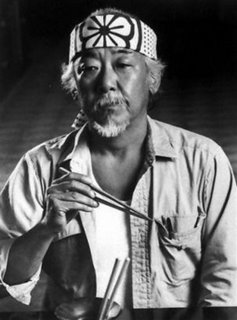
Actor Pat Morita, whose portrayal of the wise and dry-witted Mr. Miyagi in "The Karate Kid" earned him an Oscar nomination, has died. He was 73. Morita died Thursday, November 24th, 2005, at his home in Las Vegas of natural causes, said his wife of 12 years, Evelyn. She said in a statement that her husband, who first rose to fame with a role on "Happy Days," had "dedicated his entire life to acting and comedy." In 1984, he appeared in the role that would define his career and spawn countless affectionate imitations. As Kesuke Miyagi, the mentor to Ralph Macchio's "Daniel-san," he taught karate while trying to catch flies with chopsticks and offering such advice as "wax on, wax off" to guide Daniel through chores to improve his skills.
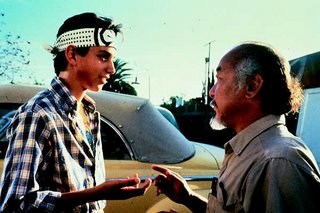
Morita said in a 1986 interview with The Associated Press he was billed as Noriyuki "Pat" Morita in the film because producer Jerry Weintraub wanted him to sound more ethnic. He said he used the billing because it was "the only name my parents gave me." He lost the 1984 best supporting actor award to Haing S. Ngor, who appeared in "The Killing Fields."
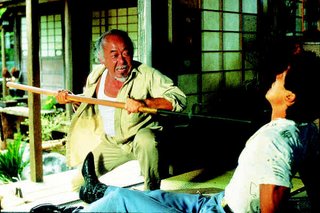
For years, Morita played small and sometimes demeaning roles in such films as "Thoroughly Modern Millie" and TV series such as "The Odd Couple" and "Green Acres." His first breakthrough came with "Happy Days," and he followed with his own brief series, "Mr. T and Tina."
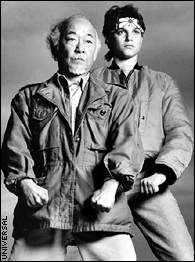
"The Karate Kid," led to three sequels, the last of which, 1994's "The Next Karate Kid," paired him with a young Hilary Swank.

Morita was prolific outside of the "Karate Kid" series as well, appearing in "Honeymoon in Vegas," "Spy Hard," "Even Cowgirls Get the Blues" and "The Center of the World." He also provided the voice for a character in the Disney movie "Mulan" in 1998.

Born in northern California on June 28, 1932, the son of migrant fruit pickers, Morita spent most of his early years in the hospital with spinal tuberculosis. He later recovered only to be sent to a Japanese-American internment camp in Arizona during World War II. "One day I was an invalid," he recalled in a 1989 AP interview. "The next day I was public enemy No. 1 being escorted to an internment camp by an FBI agent wearing a piece."
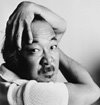
After the war, Morita's family tried to repair their finances by operating a Sacramento restaurant. It was there that Morita first tried his comedy on patrons. Because prospects for a Japanese-American standup comic seemed poor, Morita found steady work in computers at Aerojet General. But at age 30 he entered show business full time. "Only in America could you get away with the kind of comedy I did," he commented. "If I tried it in Japan before the war, it would have been considered blasphemy, and I would have ended in leg irons. " Morita was to be buried at Palm Green Valley Mortuary and Cemetery. He is survived by his wife and three daughters from a previous marriage.
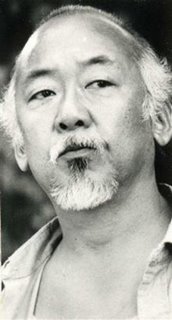
Below is an article written by Charles Goodin who is Online editor of Furyu Online and Assistant Editor of Furyu The Budo Journal. He trains in Matsubayashi-ryu karate, Muso Shinden-ryu iai and judo. In his "real life," he is a lawyer specializing in real estate and is completing his first novel.
Noriyuki Pat Morita:
In the Footsteps of a Sensei
by Charles C. Goodin
Everyone has their favorite Pat Morita role: Arnold, from Happy Days; the indecisive Japanese officer in Midway (who advised that the planes be armed with bombs. . .No, make that torpedoes). . .Ohara; Mr. T from Mister T and Tina-America's first television series starring an Asian-American; the taxi driver in Honeymoon in Vegas; the countless zany characters in two decades of Hawaii television commercials. . .
The list is long for a man who, at the age of 30, decided to leave his job as a department head of a California aerospace firm and --of all things -- would choose to become a comedian.
However, in the hearts and minds of millions of movie fans around the world Pat Morita is "Miyagi sensei." The Karate Kid, followed by the even more commercially successful Karate Kid II, propelled him into international stardom. As a result, he was nominated for an Oscar as the Best Supporting Actor in 1985. And, amidst innumerable other accolades, was last year honored with a Star on Hollywood's Walk of Fame.
While Noriyuki "Pat" Morita is undoubtedly the most recognized "sensei" in the world, he is the first to honestly admit that, except for some training for the Karate Kid films, he has never formally practiced a martial art (he was briefly exposed to judo as a teenager by his cousins but this mostly consisted of learning how to tumble).
I met Pat a few years ago through a mutual friend whose daughter trained at my karate dojo. In a very real sense he has become my screenwriting sensei and we've often met to discuss innumerable projects and ideas. Once, as we were leaving a restaurant in Honolulu a young man across the street yelled out happily at the top of his lungs, "Hey! Mr. Miyagi!"
Another time at the Ilikai Hotel an elderly Japanese gentleman came up to us and bowed very respectfully. After exchanging a few pleasantries in Japanese, Pat turned to me and explained that the man was a karate sensei from Japan who was a great admirer of his movies.
The same thing happens at the beach, or in hotels, airports, at shopping malls. . . everywhere he goes. Children are especially enchanted. You can tell from the glow on all their faces that they are meeting their hero. Morita's parents emigrated from Japan to California just after the turn of this century. He was born on June 28, 1932 as Noriyuki Morita in Isleton, California, and is the youngest of two children. His father was an itinerant fruit worker who followed the harvests and worked in the off-season as a nurseryman and handyman.
Life was simple and hard-dirt floors, a single bulb for electricity, a leaky roof. Then, at the tender age of two, the young "Nori" was stricken with spinal tuberculosis and was abruptly taken away from his family. For the next nine years, he was hospitalized at Weimar Joint Sanatorium in Northern California, and for a brief period at the Shriner's Hospital in San Francisco.
Due to the nature of his disease and the therapy of the time, young Noriyuki would spend the subsequent years bedridden in a body-cast from shoulder to knees. Unlike other children, he could not run and play, much less even walk.
". . .So I made puppets out of socks to entertain the nurses and other kids," Morita recalls. "In many ways, who knows. . .? If it weren't for my disease, I might not be where I am today. . . During that time, for a short spell (fortunately), we had a very strict head nurse-Miss Roberts. She was like a Hitler, the kind of nurse that if, during our afternoon nap, somebody giggled or farted, she would come right through the ward with an 18-inch ruler, pull back the covers and give everybody five or ten whacks. I didn't care because I had a body-cast. So all she could do was whack the cast. It made good noise. I think that's when I became an actor: 'Ow, ow, ow!' My first acting job-pain. But I think I had a lousy agent!"
During these formative years, Morita was told on a daily basis that he would never be able to walk. Eventually, four vertebra in his spine were fused. And because he was a real fighter, he would prove his doctors wrong b y walking out of the hospital at the age of 11.
In an ironic twist of fate, America had entered World War two years earlier, after Japan attacked Pearl Harbor. Morita's family, like over 110,000 other Americans of Japanese ancestry living on the West Coast (Hawaii was not subject to mass internment orders), were interned. Morita walked well enough to be picked up at the hospital by an FBI officer who transported him by car, train and bus to the Gila Internment Camp in Arizona.
Morita recalls: "I remember he wore dark glasses and had a mustache and was carrying a gun. Imagine that. I think back to the ludicrosity of it all: an FBI man escorting a recently able-to-walk spinal tubercular 11-year-old to a place behind barbed wire in the middle of nothing!"
Going directly from the confines of a hospital bed to the even-greater confinement of an internment camp, Morita was suddenly surrounded by a Japanese-speaking family and other camp internees of Japanese ancestry. He had spoken only English at the hospital, so it was a cultural shock at first. But he made friends and adapted.
"I remember doing the Pledge of Allegiance at the beginning of the school day. It was in a barracks. . . (I remember) my English class; and looking out the window and seeing the American flag waving, juxtaposed against a guard tower in the background, I had this sense of 'What's this all about?' Why am I saying 'liberty and justice for all'? I was too young to rationalize this, but I do remember that the hurt of bigotry began early on and was to last for many, many years. Whenever I think about it, it still hurts."
During the latter part of the War, the family was relocated to the Tule Lake Internment Camp in California. Recalling those camp days, the young Morita would anxiously look forward to the arrival of newspapers. Most were written in Japanese but some included small sections in English. He recalls a man walking all day throughout the camp yelling "Rocky Shinpo, Rocky Shinpo!" This was a Japanese-language newspaper published in Colorado. Sometimes other newspapers were brought or mailed by visitors and relatives.
Whenever a newspaper arrived, everyone was eager to know about the latest exploits of the Nisei (Japanese American) soldiers in the 442nd Regimental Combat Team and 100th Battalion. Cheers would resound throughout the camp whenever accounts of their heroism were read and repeated.
The soldiers in the 442nd, 100th, MIS (Military Intelligence Service; the US military's translation and interrogation unit) and 1399th were composed primarily of Japanese Americans from Hawaii and the US Mainland, who become renowned for their acts of courage and sacrifice. So many soldiers were killed or wounded in action from the 100th that it became known as the "Purple Heart Battalion." The 442nd, which absorbed the 100th and fought in Europe, became the most highly decorated unit of its size and length of service in the entire history of the US Army. And Gen. Douglas McArthur's staff credits the men of the MIS for shortening the war in the Pacific by at least two years, thereby savings countless thousands of American and Japanese lives.
Morita recalls many emotionally-charged scenes in the camps in which parents sent their sons off to serve for the very country which was imprisoning their families. He especially remembers an old man gripping his only son and saying tearfully, "You just be a good goddamn soldier. Don't embarrass your momma."
That young man, along with a great many others, would never return to his family. Morita can still envision that soldier's mother staring hour after hour at a small paper flag bordered in blue with a gold star on it. She was the "Gold Star" mother; someone who had lost a son in the war for the United States.
After the war ended and the internees were released, there were many more hard years. Eventually the family resettled in Sacramento and opened a restaurant. It was called the "Ariake Chop Suey" (after the area in Japan where Morita's father was born). They served Chinese food in apredominately black section of town. Morita and his father worked 14-hour-days in the kitchen and his mother, aunties and cousins served the food.
This probably explains why today Morita can still whip up great Chinese food. Later in life, Morita would discover that his father was able to book large parties because he included his son's services as an emcee. The young Morita developed his self-confidence performing before crowds that reached up to 300 people.
Shortly after graduating from high-school, he joined an aerospace company on the outskirts of Sacramento, where he worked his way up to becoming the head of the computer operations department. But after a number of years, Morita became discontented. His weight shot up to nearly 200 pounds which, on his 5-foot, 3-inch frame, made him look like, in his words, "a Japanese butterball." He did not have a college degree or specialized training and realized that he had reached the top of his then chosen career path.
So, despite having a good job with security, a four-bedroom home and a wife, child, mother-in-law and three household pets depending on him, he decided that he wanted something more out of life.
The rest, as they say, is show-business history. Fast forward 23 years. At the age of 53, Morita lands the role of Miyagi sensei in The Karate Kid. And, he has to work hard to earn it. There were five call-backs, five days of rigorous rehearsals, followed by three solid months of 10-hours-a-day hard training.
The executive producer of the project was initially opposed to casting a "comedian" in the dramatic role. Morita convinced him and all the studio heads that he was the definitive Miyagi.
The role was physically demanding, to say the least. Morita's childhood back problems made it impossible for him to jump around with co-star Ralph Macchio and the other young, athletic actors. But with his usual "never-say-quit" attitude, coaching by karate champion Pat Johnson, and stunt-double work by the world-renowned Fumio Demura, the action scenes in the film were to become indelibly convincing and memorable. For this author, I can say that there is a lot of Pat Morita in the Miyagi character-more than most people realize. In many ways, Miyagi is an amalgamation of Morita's father and friends from that older generation. When Morita's older brother, Harry, saw the film he said with a tear in his eye, "That's Papa up there."
The script for the film did not provide the "back story" for the character; that is, the life events which shaped the character of Miyagi and contributed to his inner strength. This essential element was largely supplied by Morita, drawing from his own life experiences and impressions.
One of the most critically acclaimed moments in the film is known as the "drunk scene" (Daniel-san races to Miyagi's house late one night after being bullied at a restaurant.) Morita recalls that the script merely stated that "Daniel finds Miyagi... three sheets into the wind. . .singing. That was it. No dialogue, no reason, no why. . . no nothing! Gimme a break."
Morita went to the director, John Avildsen, to ask about the scene. They were already in production and filming around it.
"I say, 'John, we got a problem. What's this scene all about? Three sheets into the wind, singing. -What?' God bless him forever for being receptive."
Morita suggested the use of a Japanese song he heard as a child in the internment camps. Then he added as a background, "How about every three or four years Miyagi allows himself the luxury of lamenting the son he never had, a son that was to be, a son that he would never see? But, while he was off at war, he learns that mother and child died from complications in childbirth as a result of the deplorable medical conditions present in the internment camp."
Morita also suggested that Miyagi was a 442nd vet and had received a Congressional Medal of Honor for valor in battle, which deeply troubled his psyche. "Why had he survived the horrors of battle while his wife and child died?"
All the answers to these powerful elements were supplied by Morita, but very few people were ever aware of his contribution to the scene, or of the parallels to his own life and images from his childhood.
Over the years, Morita formed many lifelong friendships with veterans of the 442nd and 100th. In fact, he has been made an honorary member of the 442nd, "C" Company, and was the emcee for their 50th anniversary celebration in Hawaii just a couple of years ago.
The veterans' group recognized that his portrayal of Miyagi as a member of the 442nd was motivated by a deep and abiding personal sense of admiration and pride. He will forever be instilled with that pride.
Morita is often asked about his role as a "sensei" and the lessons he would like to teach. He wonders why people ask such questions of "an actor who is still struggling to find his own way in life. I don't think I was put on the earth in our time to perpetuate answers to these depth-of-soul-searching questions. Rather, if at all, maybe I've been put on this earth to merely raise these queries in the hearts of others as a result of my actorial interpretive skills- to simply pose these kinds of questions: not necessarily to answer them. Good luck to each of us who walks, crawls, steps or drags through any given time on this earth. Indeed, God bless us all!"
As mentioned earlier, Morita is the first to admit that he is an actor, not a karate sensei. But, my observation is, he truly epitomizes the positive qualities of so many of the budo teachers I've met over the years. Morita has overcome seemingly insurmountable obstacles-physical, racial and professional-all with a quiet sense of determination and dignity.
What is a sensei? The word "teacher" is an in adequate translation at best, but it is formed by two characters, sen-, which means "before" or "previous," and -sei which means "born" or "life." In other words, a sensei is an elder, in particular, an elder deserving of respect. In that sense, Pat Morita is a sensei in the truest sense of the word and those of us in the budo world are fortunate and grateful for the positive role model he has established for us. But, as he has told this writer many times: "Me. . . I'm so lucky I just got to play the part."
Addenda:
I always found it interesting that the name chosen for the sensei in The Karate Kid was actually the name of a famous figure in the history of Okinawan karate-do: Miyagi Chojun (1888-1953), the founder of Goju-ryu. This Miyagi was also a participant in the 1936 "Meeting of Masters" described in Volume 1, Issue 4, Spring-Summer 1995 of Furyu ("When Masters Meet," by Patrick McCarthy, pages 10-17). Unlike the Miyagi" in The Karate Kid, however, the real Miyagi was a stocky and powerful man. In fact, there is a striking resemblance between Sato sensei (Danny Kamekona), the nemesis in Karate Kid II, and the legendary Miyagi. The irony is that both Kamekona and Morita, as well as Toshiro Mifune, were all considered to play the part of Miyagi.


0 Comments:
Post a Comment
<< Home